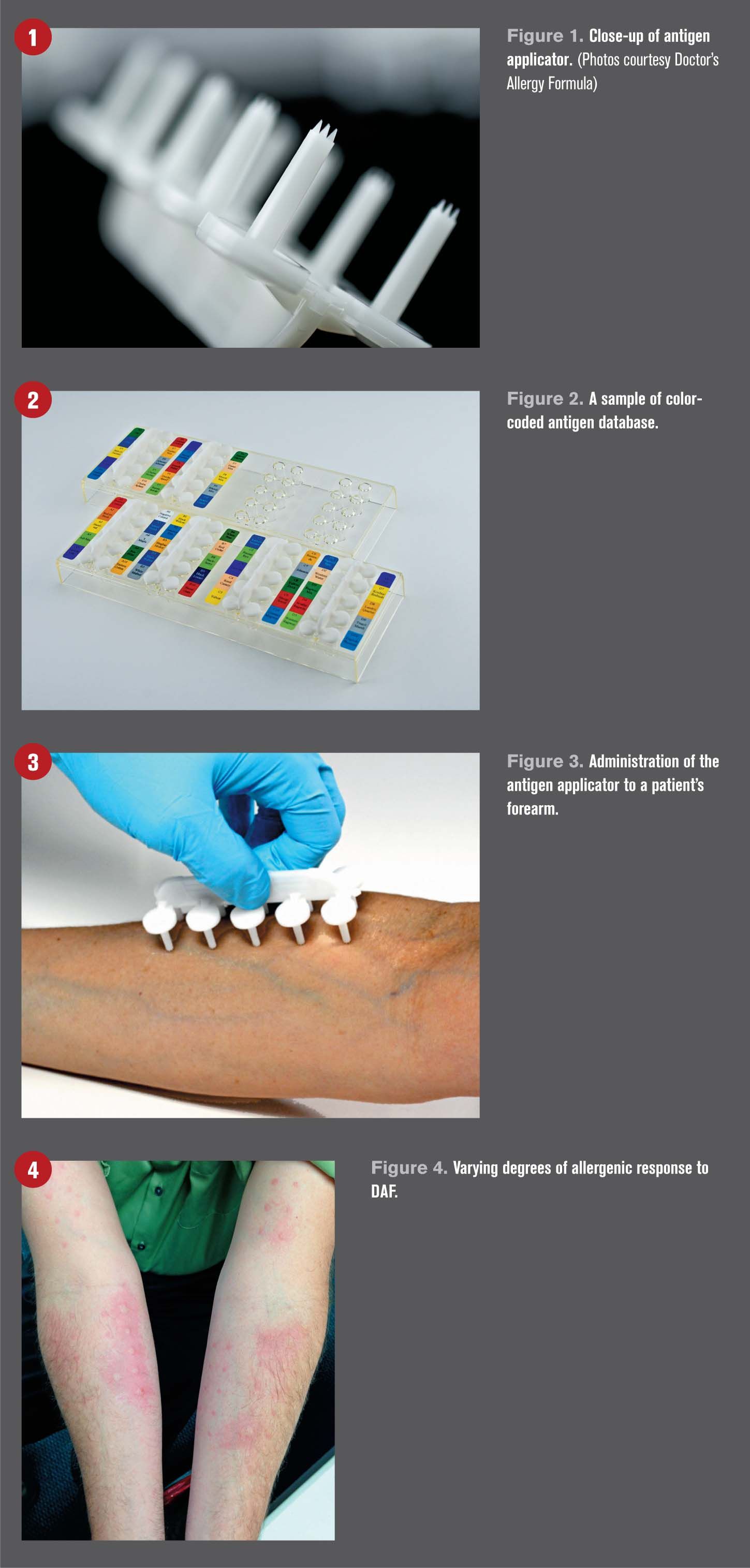A new player in point-of-care allergy testing
What would be the response if I told you that prescribing an allergy medication outright was a bandage or knee-jerk approach? Now, before everyone comes after me with pitchforks, hear me out.

The scope of ocular surface disease is a vast territory which can be treacherous and confusing for even the most skilled clinician posed by a dry eye or “allergic conjunctivitis” case-or combination thereof. Why the quotation surrounding this popular condition? The simple reason is that until recently, the eyecare community utilized subjective data collection to diagnosis this multifaceted disease, albeit with great success.
What would be the response if I told you that prescribing an allergy medication outright was a bandage or knee-jerk approach? Now, before everyone comes after me with pitchforks, hear me out. I am not stating that you have violated the sacred Optometric Oath by mistreating the patient. The thought is to expand our horizons as a profession beyond its current bounds in a more objective manner.
Scoping it out

Statistically, there are 60 million Americans affected by allergies, of which 24 million (40 percent) have some form of ocular etiology.1-3
From a public health standpoint, this is a emerging epidemic in our society for which population-based studies show that the rate of allergenic disease is increasing in magnitude.
The many faces of allergy encompass patients with classic seasonal and perennial allergic conjunctivitis to vernal keratoconjunctivitis, atopic keratoconjunctivitis, and giant papillary conjunctivitis.4
More from Dr. Cooper: 3 tips to navigate the allergy discussion with kids
Seasonal and perennial allergies cases are linked directly to the expression of specific immunoglobulin E (IgE) antibodies to environmental allergens making up the most common form of ocular allergy, affecting up to 15 to 20 percent of the population.5
In this type of ocular allergy, allergens interact with IgE bound to sensitized mast cells and after two rounds of exposure, result in a massive hypersensitivity reaction characterized by mast-cell degranulation.
Consequent increased levels of histamine, prostaglandins, leukotrienes, and other pro-inflammatory molecules in the tear film in these mast cells trigger the expression of chemokines, adhesion molecules, and other cause these mast cells to trigger the expression of chemokines, adhesion molecules, and other chemoattractive proteins.
The result is the recruit and activation of T-cells and macrophages in the conjunctival mucosa, characterizing the late-phase Type IV delayed reaction.6
Next: In the huddle, be the quarterback
In the huddle, be the quarterback
In my ocular surface disease practice, allergic conjunctivitis comprises a rolling average of 25 percent of my cases, depending on the season. With the heavy snowpack and pollen boom in Spring 2015, many emergent patients forced me to be creative in order to harness the increased workload.
How did I do it? I took a step back and delegated to my technical staff an arsenal of objective (and painless) tests such as TearLab Osmolarity Test, LipiView, and now Doctor’s Allergy Formula.
Related: Nonpharmacologic care for ocular allergies
With a methodical point-of-care approach taking fewer than 12 minutes to collect, I was able to optimize the patient experience, leading to efficient diagnosis and fewer symptomatic patients. This approach has exponentially grown my practice and created a gateway to facilitate dialogue with my fellow colleagues in the allergy, rheumatology, and endocrinology specialties.
Furthermore, I make it a priority to share the information I collect in a cordial and succinct summary through my electronic health records to provide the highest level of patient care.
Next: Doctor's Allergy Formula

Doctor’s Allergy Formula
Ocular surface disease hinges on identifying the unknown etiology. Doctor’s Allergy Formula (DAF) fits right into this mold by providing a non-invasive, no-needle, proprietary U.S. Food and Drug Administration-approved diagnostic test designed to objectively diagnose specific allergies.
When I was researching this test strategy, a component I found interesting was that it included both positive and negative controls in order to diminish false readings.
In addition, with the scientific team’s assistance, you are able to build an antigen database with up to 58 allergens that are regionally specific for higher yield depending on the practice’s geographic location.
A pearl that I have gleaned from an esteemed ophthalmology colleague of mine is that you must alert the patient to stop his allergy treatment five days prior to administering DAF to get a properly calibrated and meaningful result.
Results can be interpreted within 10 to 15 minutes, allowing for immediate patient education on the sensitive allergens and methods of avoidance. From my perspective, the ability to customize DAF is powerful and can be life altering for some severe allergy sufferers.7
In the practice management realm, the test is covered and reimbursed by all major medical insurances and Medicare using the well-established CPT-4 billing code of 95004, described as “percutaneous tests with allergenic extracts, immediate type reactions.”
The information provided by the company suggests when billing the procedure to use a quantity modifier of 60.
Finally, there is a one significant caveat where even though the code is multidisciplinary, an OD-only practice setting cannot yet participate unless associated with a MD or DO. Therefore, if you want to perform the DAF analysis, reach out to your ophthalmology peers for assistance.
Related: What's trending in ocular allergy treatment
Taking the next step
Revisiting the provocative question regarding the bandage or knee jerk response approach to medication administration-the call to action is to truly identify the specific offending allergens in order to properly manage each case.
In-office allergy testing will instill confidence in the clinician to know what role allergy plays in the ocular surface disease and also what the best treatment(s) might be for the patient.
Consequently, this new paradigm shift in ocular surface disease management will allow patients not only physical but psychological relief from their allergy symptoms by providing them a sense of knowing that their condition has been addressed in a compassionate and disciplined manner.
References:
1. Singh K, Bielory L. Epidemiology of ocular allergy symptoms in United States adults (1988-1994). American College of Allergy, Asthma & Immunology Annual Meeting; Nov 9-15, 2006; Philadelphia, PA. Abstract 34.
2. Austin JB, Kaur B, Anderson HR, et al. Hay fever, eczema, and wheeze: a nationwide UK study (ISAAC, international study of asthma and allergies in childhood). Arch Dis Child. 1999 Sep;81(3):225-30.
3. Nathan RA, Meltzer EO, Seiner JC, et al. Prevalence of allergic rhinitis in the United States. J Allergy Clin Immunol. 1997;99:S808-14.
4. Barbee RA, Kaltenborn W, Lebowitz MD, et al. Longitudinal changes in allergen skin test reactivity in a community population sample. J Allergy Clin Immunol. 1987 Jan;79(1):16-24.
5. Wong AH, Barg SS, Leung AK. Seasonal and perennial allergic conjunctivitis. Recent Pat Inflamm Allergy Drug Discov. 2009 Jun;3(2):118-27.
6. Leonardi A, De Dominicis C, Motterle L. Immunopathogenesis of ocular allergy: A schematic approach to different clinical entities. Curr Opin Allergy Clin Immunol. 2007 Oct;7(5):429-35.
7. Doctor’s Allergy Formula. “Ocular Allergy Testing. (Physician Area).” Doctor’s Allergy Formula. 2013. Available at http://drsallergyformula.com/physician.php. Accessed 6/20/2015.
Newsletter
Want more insights like this? Subscribe to Optometry Times and get clinical pearls and practice tips delivered straight to your inbox.